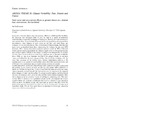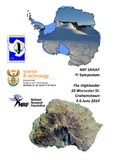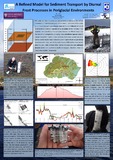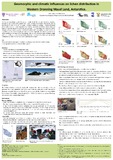
Antarctic Legacy Archive
Snow cover and zero-curtain effects on ground climate in a diurnal frost environment, Marion Island
- ALSA Home
- →
- Documents
- →
- Research: Events, Presentations, Posters
- →
- View Item
JavaScript is disabled for your browser. Some features of this site may not work without it.
| dc.contributor.author | Boelhouwers, J. | |
| dc.coverage.spatial | sub-Antarctic | |
| dc.coverage.spatial | Marion Island | |
| dc.date.accessioned | 2021-03-10T09:25:41Z | |
| dc.date.available | 2021-03-10T09:25:41Z | |
| dc.date.created | 2007/10/09 | |
| dc.date.issued | 2007/10/09 | |
| dc.identifier.uri | http://hdl.handle.net/123456789/28547 | |
| dc.description.abstract | Snow cover has a well-known thermal insulation effect on underlying soils. Similarly, the freeze-up and subsequent thaw of soils can lead to a period of isothermal conditions due to latent heat exchange of freezing and thawing soil water, known as a zero-curtain effect. These thermal effects are known for permafrost and seasonal frost environments. Here, impacts of snow cover on soil heat and water fluxes are evaluated for the maritime diurnal frost environment of Marion Island. Snowfall and snow cover is described from direct observations by Holness for the year 1999 (Holness, 2001). Ground temperature and soil moisture records at 200m, 750m and 1000m asl are used to demonstrate the effects of snow cover on the ground thermal and moisture regime. Effects of zero-curtain conditions are demonstrated in absence of snow. Snow cover is shown to occur for a significant part of the year at altitudes above 400m asl. and is an important modifier of the ground climate. As radiation inputs are buffered by the snow, the ground heat flux establishes a balance with the latent heat exchange of the melting snow. Surface temperatures stabilize at the melting point of ice, similar to a zero-curtain effect. Meltwater percolation at the end of the snow cover period may induce a rapid cooling down the soil profile. Ground temperature profiles at 750m asl show snow insulation to result in isothermal soil profiles. In the absence of snow, an effective zero-curtain effect establishes at depths of 10-20cm during winter. Complex heat flows by water advection and water vapour transport continue beneath the zero-curtain zone in response to the repeated phase changes of water near the surface. In contrast to polar regions, maritime diurnal soil frost environments snow cover not only exhibits a direct thermal insulation effect but is shown to act as a distinct source of cooling on underlying soils. The zero curtain effect is shown to be a prominent feature in this environment and reveals complex latent heat exchange mechanisms that result in a similar thermal insulation effect as snow. On Marion Island, both snow and the zero-curtain effect lower the winter mean ground temperatures to values close to the freezing point of water, to at least 80cm depth. The soil frost cycle frequency-intensity is increasingly reduced by snow cover with increasing altitude. | en_ZA |
| dc.description.sponsorship | Sponsored by the the Department of Science and Innovation(DSI) through National Research Foundation (NRF) - South Africa | en_ZA |
| dc.description.statementofresponsibility | Antarctic Legacy of South Africa | en_ZA |
| dc.format | en_ZA | |
| dc.language | English | en_ZA |
| dc.publisher | South African National Antarctic Programme (SANAP) | en_ZA |
| dc.relation | SANAP Symposium 2007 | en_ZA |
| dc.relation.ispartof | ARESSA THEME II: Climate Variability: Past, Present and Future (Posters) | en_ZA |
| dc.rights | Copyright | en_ZA |
| dc.rights | Copyright | en_ZA |
| dc.subject | Research | en_ZA |
| dc.subject | Science | en_ZA |
| dc.subject | Meetings | en_ZA |
| dc.subject | Symposium | en_ZA |
| dc.subject | SANAP Symposium 2007 | en_ZA |
| dc.subject | sub-Antarctic | en_ZA |
| dc.subject | Marion Island | en_ZA |
| dc.subject | Earth Systems | en_ZA |
| dc.subject | Research | en_ZA |
| dc.subject | Earth Science | en_ZA |
| dc.subject | Geomorphology | en_ZA |
| dc.subject | Geo Sciences | en_ZA |
| dc.subject | Earth Sciences | en_ZA |
| dc.subject | Terrestrial Science | en_ZA |
| dc.subject | Snow | en_ZA |
| dc.subject | Soils | en_ZA |
| dc.subject | Ground Climate | en_ZA |
| dc.title | Snow cover and zero-curtain effects on ground climate in a diurnal frost environment, Marion Island | en_ZA |
| dc.type | Abstracts | en_ZA |
| dc.rights.holder | Antarctic Legacy of South Africa | en_ZA |
| dc.rights.holder | Boelhouwers, J. | en_ZA |
| iso19115.mdconstraints.uselimitation | This item and the content of this website are subject to copyright protection. Reproduction of the content, or any part of it, other than for research, academic or non-commercial use is prohibited without prior consent from the copyright holder. | en_ZA |
| iso19115.mddistributor.distributorcontact | South African National Antarctic Programme (SANAP) | en_ZA |
| iso19115.mdformat.name | en_ZA | |
| iso19115.mdidentification.deliverypoint | Antarctic Legacy of South Africa, Faculty of Science, Private Bag X1, Matieland. Stellenbosch. South Africa. | en_ZA |
| iso19115.mdidentification.electronicmailaddress | antarcticlegacy@sun.ac.za | en_ZA |
| iso19115.mdidentification.organizationname | Uppsala University | en_ZA |
Files in this item
This item appears in the following Collection(s)
-
Research: Events, Presentations, Posters [480]
Material directly related to official scientific and research events



